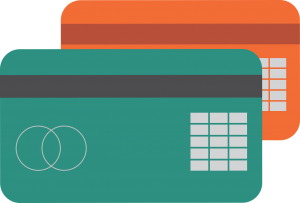Credit cards have become an integral part of our everyday life. We use credit cards for paying bills, making purchases, or simply as an emergency fund. More than 400 million credit card accounts in the US alone, with total credit card debt of 730 billion (Source). This widespread usage of credit cards imposes the need for gathering information and understanding different aspects related to credit cards. One such aspect is for you to know what is and how credit card APR works, which means that you should understand the cost of funds available on your credit cards. Although it might look fairly simple, gaining an in-depth understanding might cause some confusion. Thus, try to understand how credit cards work first.
What is credit card APR?
Annual percentage rate or APR in simple terms denotes the cost for using the funds available on your credit card, which means that it is the yearly rate on your credit card paid for the outstanding balance. Although it is expressed on a yearly basis, credit card companies are applying the APR to charge you every month. There can be differences in the APR depending on the creditor or the characteristics of the borrower.
Types of Credit Card APR
To understand how credit card APR works, you need to be familiar with the different types of credit card APR. Going through your credit card agreement, you should notice that there might be different APR rates. The different rates are stated in the terms and conditions of a credit card. Therefore, you need to know when different types of APR are applied. Their applicability depends on what you do with the available funds. Thus, you should distinguish between the following APR rates:
- Balance transfer APR – is the rate you pay if you decide to transfer the old credit card balance onto the new credit card. Often you could find offers with low (even 0%) APR for a credit card balance transfer.
- Cash advance APR – credit cards can be used in many different ways and for different purposes. One such purpose is cash advance, i.e., withdrawal of funds from an ATM. If you decide to obtain funds through a cash advance, you will be charged with this APR rate. You should be aware that this rate is usually one of the highest rates (compared to other APR rates, except the penalty rate). In addition, you do not have a grace period for the balance withdrawn at the ATM. As a consequence, a cash advance can turn out to be very costly for you. Thus, try to avoid making cash advances.
- Purchase APR – this rate, as the name suggests, is applied when you make a purchase using your credit card.
- Penalty APR – failure to pay the minimum amount due for more than 60 days will result in you being charged the penalty rate. Just to be clear, you will pay this rate on all the balances you have on your account. This rate is extremely unfavorable, and it can be 29.9%, yes you could pay an APR of 29.9%.
How your monthly interest charge is calculated?
Although you can find numerous calculators online to calculate your APR, try to understand how your APR is calculated.
Let’s say that your credit card has an APR of 16%, if you divide this by 365 (number of days in a year), you will get the value for a daily APR to be 0.04385. If, for instance, your credit card balance is $2,000, the interest is added for the day, and the next day your balance is $2,000.87. The credit card issuer will multiply your current balance by the daily interest rate to find out the daily interest charge. At the end of the next day, the interest charge is added to your balance. This process is called compounding. In addition, the next day, all other purchases are also added to the outstanding balance, while new payments are subtracted from the balance. The daily APR (and the compounding effect) is performed every day until the end of the monthly (billing) cycle.
If you want to know why a daily interest charge is preferred over a monthly interest charge, consider the length of each month. Because months have different lengths, credit card issuers prefer to use the Daily Periodic Rate (DPR). This is the rate used in the example above, it can be calculated by dividing the APR by 365.
So, to obtain the interest for the month, you should do the following calculation:
Interest for monthly statement = Balance x DPR x days in the billing cycle.
Knowing that DPR is calculated by dividing the APR by 365, the formula can be written as:
Interest for monthly statement = Balance x (APR/365) x days in the billing cycle.
The days in the billing cycle represent the number of days between two billing cycles.
After considering the APR and the daily periodic rate, what comes next is to see the role of the credit card balance. Everyone is aware that the daily balance could change from day today. This change could occur because of new purchases or money withdrawals or when you make payments to your credit cards. Because changes can occur in daily balance, banks and other financial institutions (credit card issuers) use various methods to calculate the balance. Mostly used methods to find the balance for which interest should be charged are:
- Adjusted balance – when using this method, the balance is calculated by subtracting the previous month’s balance from the total balance. The difference is the remaining balance which represents the basis for interest charges.
- Average daily balance – when this method is used, the daily balance is taken into consideration. When using this method, credit card issuers add up each month’s daily balance and then divide the amount by the number of days in the month. This method is more popular with credit card issuers when calculating the balance base for interest charges.
What is a grace period?
Because of the importance of the grace period, and for you to understand how does credit card APR works, you must be familiar with the term. Before going to the APR grace period, the term grace period should be defined. Namely, the grace period is the specific period after which the payment becomes due. Meaning that if you make your payment within the grace period, you will not be charged late penalties. When it comes to credit cards, banks offer a grace period, a period during which they will not charge you any interest. This means that if you pay off your outstanding balance during the grace period, you will pay 0% interest. This grace period is usually 25 days, so paying your balance within the period will save you money. Make sure you ask your credit card issuer about the billing cycle and the length of the grace period. If you decide to pay the minimum amount due, you will start paying interest on the outstanding balance (less the amount paid).
Therefore, many credit cards owners would like to know when the best time to make payments on their credit cards is. Well, before answering, it should be noted that paying at the right time could save you interest charges, which means that the credit card issuer will not charge you any interest. The tricky part is that you need to have enough money to pay the full statement balance on time. So, when is the correct time to pay on time? In most cases, credit card issuers are giving you a grace period to pay the full statement balance. If you pay your balance in full during the grace period, you will not be charged interest. Keep in mind that the grace period may not be applicable if you have cash advances. In this case, the credit card issuer might start calculating interest from the first day on the balance withdrawn.
How is APR determined?
When shopping around for a credit card, you must have noticed that the APR can be anywhere from 12% up to 23% (it can be higher or lower). Meaning that there could be a substantial difference in the APR you could be charged with. For this reason, you should understand the factors that determine the size of the APR you are going to pay. Some of the basic factors are:
- Your FICO score – or your creditworthiness, which has a major impact on the APR you will pay. Because there are different APRs for different credit scores, your credit card terms and conditions might list several different APRs. This APRs apply to different credit score ranges. Thus, depending on whether you have an excellent, average, or bad credit score, you will be charged the applicable APR. Simply said, the higher the FICO score, the lower the APR. This means that you should pay special attention to your credit score. Make periodical control of items in your credit score. Contact your credit bureau in case there are items recorded which should be removed.
- Another factor is the prime rate – which can be considered as a baseline interest rate. This baseline (reference) interest can change (fluctuate) in accordance with specific economic variables. Moreover, the prime rate is directly tied or related to the federal funds rate. The federal funds rate represents the rate paid by the banks for short-term borrowing from the Federal Reserve. The prime rate is the federal funds rate plus three percentage points.
- Promotional offers – is yet another factor that could impact your APR. Namely, periodically, banks have promotional offers on their credit cards. These promotional offers are one way for banks to attract new clients. Thus, make sure that you have gathered information about the promotional offers. One of the benefits of these offers is that you could be approved a credit card with a lower APR for a certain period. In addition, you could enjoy a fee-free credit card for a pre-determined period. Do not forget to collect information on the possible promotional offers.
Always keep in mind that when you pay interest, the purchased goods become more expensive. Try to understand how credit card APR works because it can save you a lot of money in the long run. If you pay back the outstanding balance on your credit cards within the grace period, you will save interest charges. Also, try to understand the different types of APR. This can also save you money in the long run. Avoid paying the penalty APR or cash advance APR, they are some of the highest you could be charged with.






